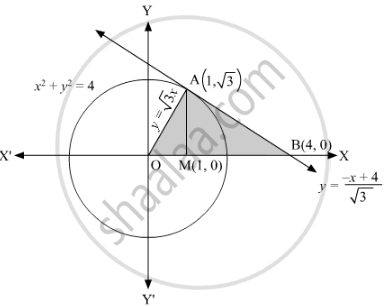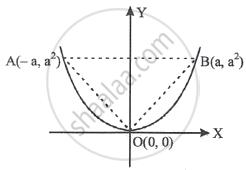Advertisements
Advertisements
Question
Using integration find the area of the triangle formed by positive x-axis and tangent and normal of the circle
`x^2+y^2=4 at (1, sqrt3)`
Solution
The given equation of the circle is x2+y2=4.
The equation of the normal to the circle at (1,√3) is same as the line joining the points (1,√3) and (0, 0), which is given by
`(y−sqrt3)/x−1=(sqrt3−0)/(1−0)`
`(y−sqrt3)/x−1=sqrt3`
`⇒y−sqrt3=sqrt3x−sqrt3`
`⇒y=sqrt3x .....(1)`
So, the slope of normal is `sqrt3.`
We know that the product of the slopes of the normal and the tangent is −1
Therefore, the slope of tangent is `−1/sqrt3`
Now, the equation of the tangent to the circle at (1,√3) is given by
`(y−sqrt3)/x−1=-1/sqrt3`
`⇒sqrt3y−3=−x+1`
⇒y=−(x+4)/sqrt3 .....(2)
Putting y = 0 in (2), we get x = 4.
Thus, ABC is the triangle formed by the positive x-axis and tangent and normal to the given circle at `(1,sqrt3)`
.

Now,
Area of ∆AOB = Area of ∆AOM + Area of ∆AMB
`=int_0^1ydx+int_1^4y dx`
`=int_0^1sqrt3xdx+int_1^4((-x+4)/sqrt3)dx`
`=[(sqrt3x^2)/2]_0^1+int_1^4-x/sqrt3dx+int_1^44/sqrt3dx`
`=(sqrt3/2-0)-[x^2/(2sqrt3)]_1^4+[4/sqrt3x]_1^4`
`=sqrt3/2-16/(2sqrt3)+1/(2sqrt3)+16/sqrt3-4/sqrt3`
`=sqrt3/2+(3sqrt3)/2`
`=2sqrt3`
Thus, the area of the triangle so formed is `2sqrt3` square units.
APPEARS IN
RELATED QUESTIONS
Find the area of the region bounded by the curve y2 = x and the lines x = 1, x = 4 and the x-axis.
Find the area of the region bounded by x2 = 4y, y = 2, y = 4 and the y-axis in the first quadrant.
Find the area of the region bounded by the ellipse `x^2/4 + y^2/9 = 1.`
The area between x = y2 and x = 4 is divided into two equal parts by the line x = a, find the value of a.
Find the area bounded by the curve x2 = 4y and the line x = 4y – 2
Area of the region bounded by the curve y2 = 4x, y-axis and the line y = 3 is ______.
Find the area under the given curve and given line:
y = x2, x = 1, x = 2 and x-axis
Find the area of the region lying in the first quadrant and bounded by y = 4x2, x = 0, y = 1 and y = 4
Find the equation of an ellipse whose latus rectum is 8 and eccentricity is `1/3`
Find the area of the region bounded by the following curves, the X-axis and the given lines: y = x4, x = 1, x = 5
Find the area of the region bounded by the following curves, the X-axis, and the given lines:
y = `sqrt(6x + 4), x = 0, x = 2`
Find the area of the region bounded by the following curves, the X-axis and the given lines: y = `sqrt(16 - x^2)`, x = 0, x = 4
Area of the region bounded by x2 = 16y, y = 1 and y = 4 and the Y-axis, lying in the first quadrant is _______.
Fill in the blank :
Area of the region bounded by x2 = 16y, y = 1, y = 4 and the Y-axis, lying in the first quadrant is _______.
Solve the following :
Find the area of the region bounded by the curve y = x2 and the line y = 10.
Area of the region bounded by the curve x = y2, the positive Y axis and the lines y = 1 and y = 3 is ______
Find the area of the region bounded by the curve y = `sqrt(9 - x^2)`, X-axis and lines x = 0 and x = 3
Find the area of the region bounded by the curve x = `sqrt(25 - y^2)`, the Y-axis lying in the first quadrant and the lines y = 0 and y = 5
Find the area of the region bounded by the curve y = `sqrt(36 - x^2)`, the X-axis lying in the first quadrant and the lines x = 0 and x = 6
Find the area of the circle x2 + y2 = 62
The area enclosed between the curve y = loge(x + e) and the coordinate axes is ______.
Equation of a common tangent to the circle, x2 + y2 – 6x = 0 and the parabola, y2 = 4x, is:
If a2 + b2 + c2 = – 2 and f(x) = `|(1 + a^2x, (1 + b^2)x, (1 + c^2)x),((1 + a^2)x, 1 + b^2x, (1 + c^2)x),((1 + a^2)x, (1 + b^2)x, 1 + c^2x)|` then f(x) is a polynomial of degree
The area of the circle `x^2 + y^2 = 16`, exterior to the parabola `y = 6x`
The area bounded by the x-axis and the curve y = 4x – x2 – 3 is ______.
The figure shows as triangle AOB and the parabola y = x2. The ratio of the area of the triangle AOB to the area of the region AOB of the parabola y = x2 is equal to ______.

The area bounded by the curve | x | + y = 1 and X-axis is ______.
